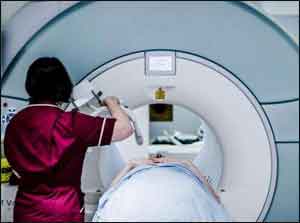- Home
- Editorial
- News
- Practice Guidelines
- Anesthesiology Guidelines
- Cancer Guidelines
- Cardiac Sciences Guidelines
- Critical Care Guidelines
- Dentistry Guidelines
- Dermatology Guidelines
- Diabetes and Endo Guidelines
- Diagnostics Guidelines
- ENT Guidelines
- Featured Practice Guidelines
- Gastroenterology Guidelines
- Geriatrics Guidelines
- Medicine Guidelines
- Nephrology Guidelines
- Neurosciences Guidelines
- Obs and Gynae Guidelines
- Ophthalmology Guidelines
- Orthopaedics Guidelines
- Paediatrics Guidelines
- Psychiatry Guidelines
- Pulmonology Guidelines
- Radiology Guidelines
- Surgery Guidelines
- Urology Guidelines
FDA releases advisory to improve safety of Magnetic Resonance Imaging

The US Food and Drug Administration has recently released advisory to improve Magnetic Resonance Imaging (MRI) safety. The advisory provides recommendations on testing to assess the safety and compatibility of medical devices in the Magnetic Resonance (MR) Environment and the recommended format for MRI Safety Information in medical device labelling.
The increasing clinical demand for Magnetic Resonance Imaging (MRI) with its superior soft-tissue contrast compared to other radiological imaging modalities and potential physiological and functional applications have contributed to the installation of almost 30,000 MRI scanners worldwide. Therefore, more and more healthcare professionals need to be trained in MRI safety to protect patients and other healthcare workers from the potential risks of MRI. Keeping this concern in mind the US FDA on August 1 published a list of advisory to further ensure the safety of patients and staff in MRI environments and reinforce both safety testing and MRI information in medical device labelling.
- Heating
- Medical device malfunction
- The extent of image artefacts
- Reporting results
- MRI safety labelling
Relative to heating, the document discusses the interaction between the radiofrequency (RF) coils, RF transmits mode, the scanner's magnet, a patient's anatomy, and any implanted devices. RF safety evaluations "should take into consideration all these variables to ensure that a clinically relevant worst-case heating scenario is assessed," the FDA wrote. "Such evaluation can include appropriate experimental measurements, computational modelling, and simulations."
Metallic implants or other medical devices can adversely affect MR image quality and falsely mimic the presence of disease. The FDA suggests that facilities perform a qualitative assessment of image quality and measurement of signal-to-noise ratio using standardized test methods from organizations such as the National Electrical Manufacturers Association (NEMA), with and without the medical device present.
The Food and Drug Administration advisory adds guidance on labelling information that should be included in premarket approval (PMA) applications, humanitarian device exemption applications, 510(k) premarket notification submissions, investigational device exemption applications, and de novo requests.
for further reference, click on the link
Guidance document

Disclaimer: This site is primarily intended for healthcare professionals. Any content/information on this website does not replace the advice of medical and/or health professionals and should not be construed as medical/diagnostic advice/endorsement or prescription. Use of this site is subject to our terms of use, privacy policy, advertisement policy. © 2020 Minerva Medical Treatment Pvt Ltd